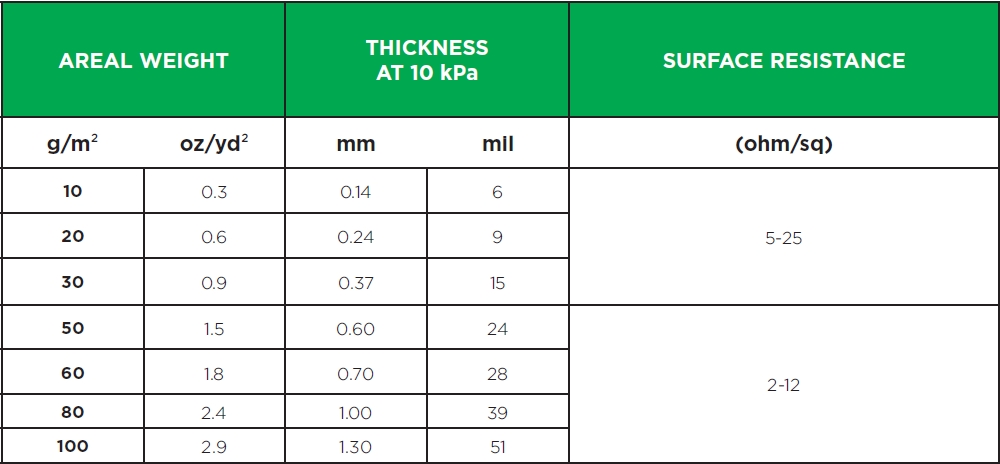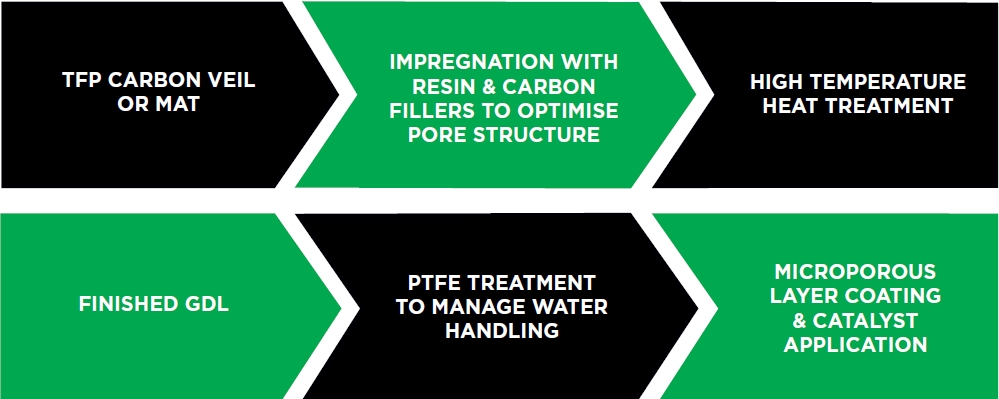TFP and TFP Hydrogen Products’ advanced nonwoven and electrochemical materials play an important role in enabling emerging hydrogen technologies; fuel cells are a prime example of this.
MARKET LEADING GDL SUBSTRATE
TFP has been developing and optimising material for fuel cell GDLs for over 30 years, working alongside some of the leading companies in the industry.
This long term commitment to hydrogen fuel cell development and growth has facilitated a comprehensive understanding of the necessary material characteristics to achieve a high performance GDL substrate, as well as enabling the company to build the capability, expertise and capacity to meet the forecast growth in fuel cell production.
The result of this long term development is a range of carbon papers which can be tailored to suit the requirements of both stationary and portable fuel cell systems. To date our nonwovens have been used extensively within the industry as GDL substrate for proton electrolyte membrane (PEMFC), phosphoric acid (PAFC) and direct methanol (DMFC) fuel cells.
WHY IS THE GDL SO IMPORTANT?
TFP’s carbon nonwoven is widely utilised as a substrate for the GDL, a critical component of the MEA which is the heart of the fuel cell. The GDL forms the basis of both the anode and cathode, and is responsible for water management, the transport of reactants, electricity and heat, as well as providing structural support to the assembly.
The GDL must be both electrically and thermally conductive to allow current flow, and have a suitable pore structure to optimise mass transport. The structure must also exhibit the correct balance of hydrophobicity, to manage the movement of water and gases in the MEA. This latter property is critical to the efficient operation of the cell; if the GDL is too wet during operation the by-product (water) is not being effectively removed, flooding may occur and reactant gas movement is impeded. Equally, if the GDL is too dry then the membrane will dry out causing higher resistance. In both cases the performance of the cell is reduced.


TFP NONWOVENS - IDEAL GDL PROPERTIES
The properties of our carbon nonwovens fulfil the performance requirements and material characteristics needed from a GDL substrate. These attributes include:
CONTROLLED POROSITY:
Our veils are highly porous and the pore structure can be tailored to accommodate different types of carbonaceous filler and post treatments.
CONDUCTIVITY:
TFP’s carbon nonwovens have high in-plane & through-plane electrical and thermal conductivity, so effective electrical conduction and heat transfer between the catalyst and the current collector plates can occur.
CHEMICAL RESISTANCE:
TFP’s range of carbon mats and veils inherently exhibit good chemical & corrosion resistance to reactant gases.
HIGH SURFACE AREA:
Our materials are highly porous and provide a large surface area. This aids optimum control of reactant gas and water movement during operation, helping to maintain effective mass transport and efficient cell performance.
DURABILITY:
Our nonwovens provide excellent durability & strength. They exhibit controllable and repeatable compressibility. This is important both in stack assembly to accommodate thickness variation in cell stack components, as well as during operation to adapt to the thermal expansion seen in larger fuel cell stacks.
EVEN SURFACE:
The superior even fibre distribution characteristic of our nonwovens provides a suitable architecture for application of a smooth microporous layer coating.
OUR CARBON GDL SUBSTRATE
TFP manufacture a range of carbon papers which are used extensively as a GDL substrate. The materials are produced from PAN carbon fibre and are available in a range of basis weights from 8 to 200 g/m2. Indicative properties for these are shown below, but properties can be tailored to suit the specific system requirements:

The basis weights shown are typical of those manufactured, other weights are available to suit specific application requirements.
CREATING A GDL USING TFP’S SUBSTRATE
TFP’s carbon paper has been developed specifically as the ideal substrate from which to produce a GDL, the process to achieve this is as follows:

NEED MORE INFORMATION?
Please Get in Touch.
